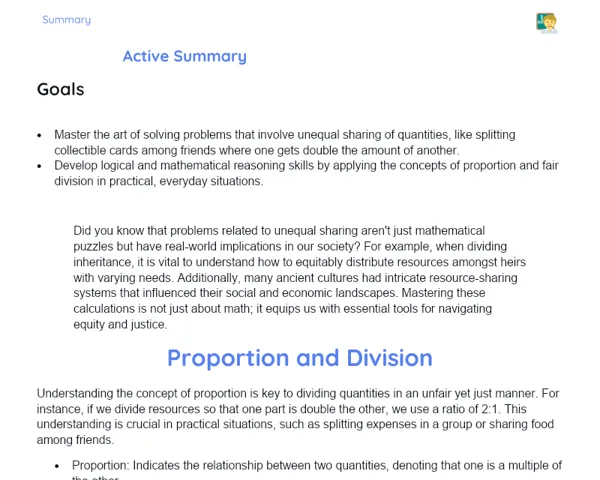Objectives
1. Understand and apply the formula to calculate the area of a trapezoid: S = h(B + b) / 2.
2. Develop practical skills to solve real-world problems involving area calculations, such as land sizing or planning event spaces.
Contextualization
Did you know that being able to calculate the area of shapes like the trapezoid is essential in fields like architecture and urban planning? Architects and city planners often have to work with plots that are not regular in shape, making it necessary to understand and accurately calculate areas for effective space use. So, by mastering the trapezoid formula, you're not just learning mathematics; you're also equipping yourself with a vital tool that will help you in various technical careers!
Important Topics
Trapezoid Area Formula
The formula for calculating the area of a trapezoid is S = h(B + b) / 2, where 'h' is the height of the trapezoid, and 'B' and 'b' denote the lengths of the longer and shorter bases, respectively. This formula is crucial for calculating areas in situations that aren't perfectly rectangular, which is often encountered in practical tasks like construction and public space design.
-
The height (h) is always taken as the perpendicular distance between the two bases, irrespective of the angles of the sides.
-
The lengths of the bases (B and b) can vary, which sets trapezoids apart from shapes like rectangles or squares.
-
This formula serves as a practical example of how mathematics is applied in real life, aiding in resolving complex design and space-related challenges.
Practical Applications of Area Calculation
Calculating the area of trapezoids has numerous applications in real-world scenarios, including urban planning, interior design, and architecture. For example, architects leverage this skill to optimize the use of irregular spaces, and engineers might need to calculate the quantity of materials required based on a plot's area.
-
In urban planning, the ability to calculate the area of irregular plots is essential to develop both public and private spaces efficiently.
-
In architecture, the formula assists in creating designs that fit the unique characteristics of the environment, making the best use of every square meter.
-
Setting up outdoor events often involves arranging temporary structures in irregular spaces, where accurate area calculation is key for effective logistics and safety.
Challenges in Applying the Formula
Although the trapezoid area formula is straightforward in theory, practitioners may face challenges when applying it in real-world situations. This includes accurately measuring the bases and height on irregular plots and taking into account surface variations that might alter measurements.
-
Accurate measurements are critical, as mistakes can result in miscalculations, affecting an entire project or plan.
-
Irregular plots with slopes may require different methods for measuring height, which must always be perpendicular to the bases.
-
Gaining practical experience and using modern measuring tools can help overcome these challenges and ensure precise calculations.
Key Terms
-
Trapezoid: A four-sided figure with at least one pair of parallel sides, referred to as the bases.
-
Area: The measurement of the internal space within a two-dimensional shape, expressed in square units.
-
Larger Base (B) and Smaller Base (b): The parallel sides of a trapezoid, where typically one is longer than the other.
-
Height (h): The perpendicular distance separating the bases of a trapezoid.
For Reflection
-
How might calculating the area of a trapezoid affect the design of a public area you often visit?
-
Why is it essential for professionals like architects and urban planners to grasp and use the trapezoid area formula accurately?
-
In what ways can collaborative efforts enhance accuracy and efficiency when tackling area calculations in real-life projects?
Important Conclusions
-
In this summary, we covered the formula S = h(B + b) / 2 for calculating the area of a trapezoid. This knowledge is fundamental not only for mathematical exercises but also for practical uses in fields such as architecture and urban planning.
-
Being able to calculate the area of geometric shapes like the trapezoid is vital for various technical professions and can assist in everyday tasks like planning event spaces or optimizing land use.
-
We also discussed the potential challenges when applying these formulas, such as the need for precise measurements and considerations regarding the terrain, which underscores the importance of mathematical accuracy in real-life situations.
To Exercise Knowledge
- Draw a trapezoid on graph paper and calculate its area using the learned formula. 2. Use household items to design an event layout within a trapezoidal space, and determine the area occupied by each object. 3. Visit a park or open space in your locality and try to estimate the area of the trapezoidal sections you can find, using the formula.
Challenge
Design the layout for a mini music festival on a trapezoidal plot. Include stage areas, food zones, and relaxation corners. Calculate the total area required and tweak the design to maximize space utilization!
Study Tips
-
To practice, find trapezoid shapes in magazines or newspapers, and calculate their areas.
-
Create flashcards with different area calculation problems and practice with friends or family to reinforce your understanding.
-
Utilize drawing or modeling applications to visualize trapezoids and other geometric shapes, which can help you better grasp their properties and measurements.



